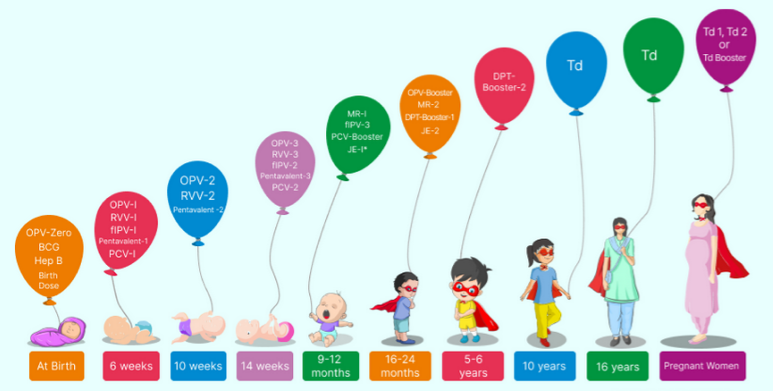Universal Immunization Programme
The immunization program plays a vital role in safeguarding children from preventable, life-threatening diseases. As one of the world’s largest initiatives of its kind, it stands as a cornerstone of public health efforts within the country.
India’s immunization initiative traces its origin back to 1978, when it emerged as the Expanded Programme of Immunization (EPI). This foundational effort laid the groundwork for a broader vision, which, in 1985, transformed into the Universal Immunization Programme (UIP). Executed in incremental phases, the UIP aimed to encompass every district across the nation by the close of 1989-90.
By 1992, this vital program was integrated into the Child Survival and Safe Motherhood Programme, enhancing its scope and efficacy. In 1997, immunization endeavors became a cornerstone of the National Reproductive and Child Health Programme, underscoring their importance in safeguarding the well-being of future generations. Since 2005, these activities have been pivotal under the umbrella of the National Rural Health Mission (NRHM), reinforcing their status as a key pillar of public health advancement.
Under the Universal Immunization Programme, the Government of India administers vaccines to safeguard against eleven preventable diseases. These include Diphtheria, Pertussis (Whooping Cough), Tetanus, Polio, Measles, Rubella, severe forms of Childhood Tuberculosis, Hepatitis B, Haemophilus Influenzae type B (Hib), Pneumococcal infections, and Diarrhea caused by Rotavirus.
National Immunization Schedule
| S.No. | Vaccine Name | When to give | Dose | Route | Site |
|---|---|---|---|---|---|
| 1 | BCG | At birth or as early as possible till one year of age | 0.05ml until 1 month of age, 0.1 ml after that | ID | Left Upper Arm |
| 2 | Hepatitis B Birth Dose | At birth or as early as possible within 24 hours | 0.5ml | IM | Anterolateral side of mid thigh-Left |
| 3 | OPV Birth dose | At birth or as early as possible within the first 15 days | 2 drops | Oral | Oral |
| 4 | OPV 1,2 & 3 | At 6 weeks, 10 weeks & 14 weeks | 2 drops | Oral | Oral |
| 5 | fIPV | At 6 and 14 weeks | 0.1ml | ID | Right Upper Arm |
| 6 | Pentavelant 1,2 & 3 | At 6 weeks, 10 weeks & 14 weeks | 0.5ml | IM | Anterolateral side of mid thigh-Left |
| 7 | Rota Virus Vaccine | At 6 weeks, 10 weeks & 14 weeks | 5 drops | Oral | Oral |
| 8 | PCV (Penumococcal Conjugate Vaccine) | At 6 weeks & 14 weeks at 9 completed months booster | 0.5ml | IM | Anterolateral side of mid thigh-Right |
| 9 | MR (Measles Rubella)1st Dose | At 9 to 12 months. (up to 5 years if not received at 9-12 months) | 0.5ml | SC | Right Upper Arm |
| 10 | Vitamin A, 1st Dose | At 9 months with MR | 1 ml (1 lakh IU) | Oral | Oral |
| 11 | DPT 1st booster | 16-24 months | 0.5ml | IM | Anterolateral side of mid thigh-Left |
| 12 | OPV Booster | 16-24 months | 2 drops | Oral | Oral |
| 13 | MR (Measles Rubella) 2nd dose | 16-24 months | 0.5ml | SC | Right Upper Arm |
| 14 | Vitamin A (2nd to 9th dose) | At 16 months with DPT/OPV booster, then, every 6 month up to age of 5 years | 2ml (2 lakh IU) | Oral | Oral |
| 15 | DPT 2nd Booster | 5-6 years | 0.5ml | IM | Left Upper Arm |
| 16 | Td | 10 years & 16 years | 0.5ml | IM | Upper Arm |
| 17 | Td-1 | Give as early as possible in pregnancy | 0.5ml | IM | Upper Arm |
| 18 | Td-2 | 4 weeks after Td-1 | 0.5ml | IM | Upper Arm |
| 19 | Td-Booster | If received 2 Td doses in a pregnancy within the last 3 years | 0.5ml | IM | Upper Arm |

